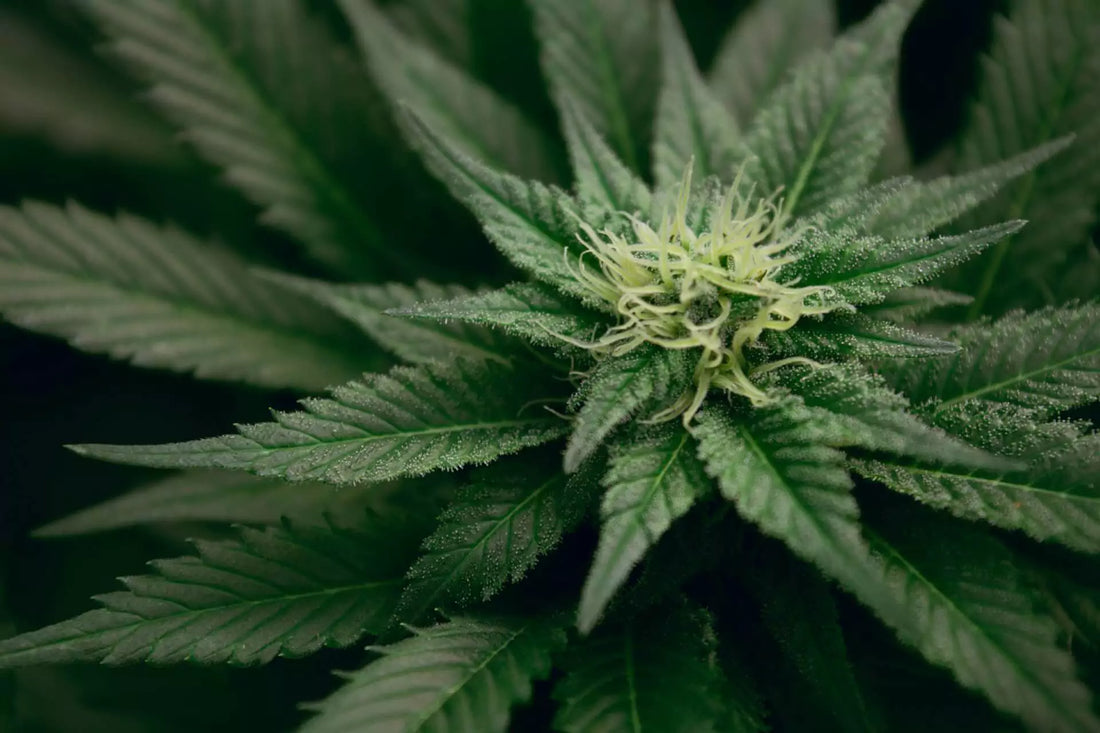
Our Blog
What is CBG?
What is CBG?
When it comes to cannabis, the fact of the matter is most people only have a surface-level understanding. Most people know that smoking will have intoxicating effects, fewer people have in-depth knowledge about the health benefits. Fewer still really understand the chemical compounds and the biochemical mechanisms by which these benefits are realized.
You're not like most people though. You're here trying to learn more about a specific cannabinoid and what it can do for you. Well, don't worry; you're about to get an education. Let's take an in-depth look at CBG and really get to know this novel compound.
So What Exactly Is CBG?
No, it's not a now-defunct punk club in New York. CBG, or cannabigerol, is a naturally occurring cannabinoid that's been getting a lot of attention recently. Often referred to as the "mother of all cannabinoids," CBG is the precursor from which other cannabinoids like THC and CBD are synthesized. Discovered in the 1960s, CBG is on a lot of people's radar for its unique properties and potential therapeutic benefits.
While research on CBG is still in its early stages, preliminary studies suggest that it may play a major role in the various health benefits of the cannabis plant overall, including anti-inflammatory properties and neuroprotective effects. More on that in just a bit. First, let's take a look at what sets CBG apart from its more well-known cannabinoid cousins, CBD and THC.
How Does CBG Differ from CBD?
While CBG and CBD both share a lot of commonalities, there are still some pretty important differences to note. Both cannabinoids are non-psychoactive and are appreciated for their potential health benefits, but they interact with the body in different ways.
CBD has made a reputation for itself over the past ten years or so for promoting relaxation, reducing anxiety, and providing a sense of calm throughout the day. On the other hand, CBG is getting notoriety for more versatile effects. Some studies suggest that CBG may have unique antibacterial and anti-inflammatory properties, making it a good choice for those interested in natural remedies for conditions like inflammatory bowel disease or other gut-related issues.
How Does CBG Differ from THC?
Now, let's talk about CBG's relationship with THC. While THC is widely known for its psychoactive effects that produce the classic cannabis high, CBG stands in stark contrast. As a non-psychoactive cannabinoid, CBG allows you to enjoy its potential benefits without the intoxicating effects associated with THC.
Users report that CBG may promote a sense of balance and clarity rather than the euphoric but intoxicating sensations THC provides. This makes CBG a great option for people who want the therapeutic benefits of cannabis without feeling off or altered. Whether you're exploring cannabis for the first time or looking for ways to incorporate cannabinoids into your wellness routine, CBG can offer a unique, sober-friendly experience that complements your lifestyle. You're not going to be giggly or loopy after using it, and your perception won't be altered in any significant way.
So now that we have a pretty decent foundational understanding of CBG, let's take a look at its chemistry.
Understanding the Chemical Structure of CBG
To truly appreciate what CBG can do, it helps to take a closer look at its chemical structure. CBG is classified as a phytocannabinoid, which means it originates from the cannabis plant. Its chemical formula is C21H30O2. Structurally speaking, it includes a series of interconnected rings and carbon chains typical of many cannabinoids.
At its core, CBG is a cannabinoid precursor, meaning it serves as the building block for other cannabinoids, like the more well-known THC and CBD. This unique role is rooted in its structure, specifically in its arrangement of carbon atoms. CBG begins as cannabigerolic acid (CBGA), which is the acidic form that converts to various cannabinoids through a process called decarboxylation. This transformation occurs when heat is applied or during the aging process of the cannabis plant.
Understanding CBG's chemical makeup helps explain its interactions within the body's endocannabinoid system, or ECS for short. The ECS plays a vital role in regulating various physiological processes, including mood, sleep, and pain sensation. CBG binds to cannabinoid receptors in the ECS, primarily the CB1 and CB2 receptors, which influences its potential effects. By engaging with these receptors, CBG may promote anti-inflammatory responses and neuroprotective effects, setting it apart from other cannabinoids.
Research on CBG is still pretty rudimentary, but as studies continue to explore how it interacts within the body, its potential applications in wellness and medicine are becoming pretty exciting. Now that we understand its chemistry let's take a look at how that structure has real-world impacts on people's everyday lives.
The Effects of CBG
Like we said above, research on CBG is ongoing but promising. One of the most notable characteristics of CBG is its anti-inflammatory properties. Early studies indicate that CBG may help reduce inflammation in conditions like inflammatory bowel disease and other gut-related issues. It also interacts with the body's endocannabinoid system and may help regulate immune responses and support the body's natural healing processes. Pretty powerful stuff.
In addition to its anti-inflammatory effects, CBG has also been linked to potential neuroprotective effects. Preliminary research suggests that CBG might help neurons resist aging and breaking down, making it really interesting to folks studying neurodegenerative diseases like Alzheimer's and Parkinson's.
Another area where CBG shows promise is with mood regulation. While it doesn't produce the high associated with THC, users have reported feelings of balance and calm while using it. This makes CBG an attractive option for those looking to manage anxiety or stress without the psychoactive effects that can accompany other cannabinoids.
One last benefit — CBG might also have antibacterial properties, which could be beneficial for skin conditions and infections. We're not ready to start making hand soap out of it, but it's a pretty interesting effect nonetheless.
Alright, now that we have a good handle on the effects, let's shift gears a bit and take a look at the legality of CBG. As you know, cannabis exists in some legal gray areas, so we want to be clear on how and where you can use this cannabinoid without getting into any legal issues.
Is CBG Legal?
Navigating the legal landscape of cannabinoids can be a bit like wandering through a maze, but you need to have a clear understanding of these intricacies if you're interested in exploring the potential benefits of cannabis.
So let's get into it. CBG is primarily derived from hemp, which has been federally legal in the United States since the passage of the 2018 Farm Bill. This landmark legislation legalized hemp and its derivatives, provided they contain less than 0.3% THC by dry weight.
Under the 2018 Farm Bill, CBG falls within the legal framework for hemp-derived cannabinoids, meaning it is generally considered legal at the federal level if it has the right paper trail. This has opened the door for a wider variety of CBG products to enter the market, from oils and tinctures to edibles and topicals.
While the federal legal status is clear, it's important to recognize that state laws can vary significantly. Some states have embraced all hemp-derived cannabinoids, including CBG, while others may have restrictions or outright bans on specific compounds. This means that even if CBG is legal on a federal level, it may not be permitted in your particular state. It's also important to know that as research continues to uncover the potential health benefits of CBG, the legal landscape may evolve. Ongoing studies could lead to shifts in how cannabinoids are classified and regulated, particularly as more data emerges regarding their safety and efficacy. So keep an eye on legislative developments. Things can always change.
So now that you have a good grasp on the legal issues surrounding CBG, let's keep going and talk about some more risk factors associated with its use. Here's a spoiler, though — there aren't many.
Are There Any Risks Associated With CBG?
Like most non-psychoactive phytocannabinoids, CBG is generally considered safe. That said, it's important to approach any cannabinoid use with a sense of caution and awareness of potential risks. As with any supplement or therapeutic substance, individual experiences can vary widely, and understanding the possible side effects and interactions can help ensure a positive experience.
One of the biggest concerns with CBG is the limited amount of research that's available about it. While initial studies suggest promising effects, the scientific community has not yet fully explored the long-term safety profile of CBG. That means we still have a lot to learn about its potential side effects and interactions with other medications.
Some users have reported mild side effects when using CBG, although these tend to be on the lower end of the spectrum. Possible effects may include drowsiness, dry mouth, or changes in appetite. While these side effects are generally considered manageable — or barely noticeable — it's smart to monitor how your body reacts, especially if you're trying CBG for the first time.
Another consideration is the potential for drug interactions. CBG, like other cannabinoids, may interact with certain medications, particularly those that are metabolized by the liver. If you are taking any medications or have underlying health conditions, you really need to talk with a healthcare professional before incorporating CBG into your routine. This ensures that you can safely explore the benefits of CBG without risking any adverse effects.
So we've talked about the risks, let's flip things around and talk about how to use CBG effectively and safely.
How Should I Use CBG?
Whether you're exploring CBG for its potential anti-inflammatory properties, mood support, or overall well-being, there are a few things to keep in mind to help you maximize CBG's benefits while minimizing any risks.
Consult with a Healthcare Professional
First things first, you need to talk to a doctor. This is especially true if you're taking other medications or managing specific health conditions. Your healthcare provider can give you personalized advice, help you navigate potential interactions, and ensure that CBG is a safe option for you. Their guidance will also help you develop a comprehensive approach to your health and wellness.
Start with Low Doses
As with any new supplement, it's always smart to take things slow. Begin with a small dose of CBG to gauge your body's response. Remember that individual reactions can vary, and starting at a lower dose allows you to assess how CBG affects you without overwhelming your system. Once you're comfortable, you can gradually increase the dosage as needed, taking note of any changes in how you feel.
Choose the Right Product
CBG comes in various forms, including oils, capsules, tinctures, and edibles. Consider your personal preferences and lifestyle when selecting a product. If you prefer something tasty, CBG-infused gummies may be your go-to, or if you're looking for something quick and discrete, a tincture might be the right move. Regardless of the form, you really need to make sure that you purchase your products from reputable brands that provide third-party lab testing to confirm their quality and potency.
Timing Matters
Timing your CBG intake can also enhance its effectiveness. If you're using CBG for its calming effects, consider taking it in the evening to help unwind and promote better, more restful sleep. On the other hand, if you're exploring CBG for daytime support, a morning dose may help you stay balanced and focused throughout the day. Pay attention to how CBG affects your energy levels and adjust your timing accordingly.
Monitor Your Body's Response
As you incorporate CBG into your routine, keep track of how your body responds to it. This includes noting any side effects, mood changes, or improvements in the conditions you're targeting. It might sound a little weird, but keeping a journal can help you identify patterns and determine the optimal dosage and timing for your needs. If you experience any adverse effects, you'll know how you should adjust your dosage.
Final Thoughts on CBG
Cannabis really is a fascinating plant, and there are a ton of benefits users can realize if it's used thoughtfully. There's a lot more work to be done, but as research progresses and our understanding deepens, CBG could very well become a staple in holistic health. So, if you're looking for a cannabinoid that offers a gentle nudge into a calmer, healthier life without the psychoactive effects of THC, CBG might just be the perfect fit for your journey.





